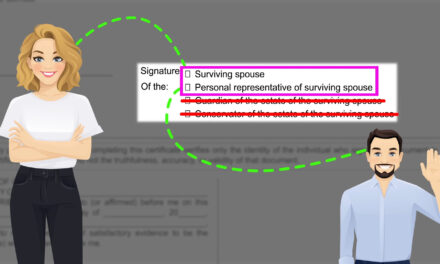The seller’s objectives encounter a buyer’s offer
On submission of a buyer’s offer to purchase a property listed with a broker for sale, the seller, with the assistance and advice of the seller’s agent, either:
- accepts the offer precisely on the terms submitted;
- responds with a counteroffer to the terms submitted [See RPI Form 180]; or
- rejects the offer without making a counteroffer, thus terminating further negotiations with the buyer submitting the offer. [See RPI Form 184]
The use of a counteroffer allows a seller’s agent and seller to take the reins of negotiations a prospective buyer has handed over when they submitted a purchase agreement offer. [See RPI Form 150]
For the seller’s agent, the counteroffer gives rise to the special duty to care for and protect the seller, which, includes:
- addressing property disclosures the seller needs to make to perfect negotiations before the seller enters into a purchase agreement with the prospective buyer;
- clarifying any uncertainties about the buyer’s financial ability to close escrow; and
- opening negotiations on terms or conditions sought by the seller which differ from those contained in the buyer’s offer.
Further, a counteroffer allows the seller’s agent to eliminate contingency provisions in the buyer’s offer. Also, the seller’s agent takes steps to establish the buyer’s qualifications for any purchase-assist financing requirements and the source of other funds needed by the buyer to timely close the transaction. [See RPI e-book Real Estate Practice Chapter 41]
Related article:
Client Q&A: What are contingency provisions? Do I need them?
The seller’s agent’s analysis
The environment surrounding the seller’s agent’s analysis of the buyer’s offer and review of the offer with their seller is nearly always within the exclusive control of the seller’s agent.
The agent uses this opportunity to sort through the paperwork before the seller enters into a binding contract and fixes expectations by all participants about the terms of the agreement and condition of the property.
A prompt, initial review of the buyer’s offer by the seller’s agent — alone and before meeting with the seller — is necessary for the agent to properly prepare for submitting, reviewing and advising the seller on the financial and legal consequences of accepting the offer.
Typically, a seller’s first comments which the seller’s agent needs to be prepared to answer, focus on:
- pricing;
- transactional costs;
- ability of the buyer to close escrow; and
- what amount the seller will receive in net sales proceeds.
Collaterally, the seller’s agent is primarily concerned with:
- preparation for their meeting with the seller to cover transactional aspects the seller needs to be aware of before the seller decides to accept or reject the buyer’s purchase agreement offer [See RPI Form 180 and 184]; and
- the seller’s obligation owed prospective buyers to disclose their knowledge about conditions on or about the property which, when not disclosed prior to entering into a purchase agreement, might:
- affect the price a prudent buyer is willing to pay for the property;
- lead to the buyer’s cancellation of the purchase agreement; or
- increase the seller’s transactional-closing costs when the buyer demands the seller eliminate previously undisclosed and unacceptable conditions first brought to the buyer’s attention due to a delayed disclosure or discovery.
The diligent seller’s agent
The duty a seller’s agent owes to their seller on submission and review of a buyer’s purchase agreement offer includes:
- advice on the seller’s obligations to disclose property conditions and possibly eliminate defects;
- a review of the agent’s concerns about the acceptability or modification of contingency provisions which might affect closing;
- disclosure of the estimated net sales proceeds the offer will generate; and
- a discussion about the agent’s knowledge of the formulas for profit tax liability the seller is likely to incur on the sale when the property is other than one-to-four residential units.
For example, an agent representing a prospective buyer submits a purchase agreement offer on the property without first requesting a copy of the marketing package from the seller’s agent for review with their buyer.
Here, the buyer does not take into consideration any adverse property conditions disclosed in the marketing package when the buyer made their decision about the price and terms on which they are willing to pay to buy the property.
To eliminate this asymmetry of property information, the seller’s agent advises the seller to counter the offer and include as addenda all the necessary disclosures. Due to the agent’s insistence when listing the property, the disclosures are already prepared and are available for the prospective buyer to approve in a counteroffer before both the seller and buyer enter into a purchase agreement. [See RPI Form 180]
A marketing package contains all the property disclosures the seller and seller’s agent are required to deliver to a prospective buyer at the earliest opportunity — either on request, and always before an unconditional acceptance of an offer or counteroffer.
Further, pre-contract property disclosures eliminate most of the contingencies which affect the price, the amount of the seller’s transactional expenses or the buyer’s ability to cancel the purchase agreement.
Related article:
Various responses to a buyer’s offer
Several contractual procedures exist for a seller to respond to an unacceptable offer, especially an offer that needs only a few minor changes to be acceptable to the seller.
For a response that includes numerous or major additions or changes in the terms of payment, performance of conditions (contingencies), due diligence procedures and closing activities, consider using a freshly prepared purchase agreement form for the seller to sign and submit. Here, as the changes are significant, a new purchase agreement is the best vehicle to document the seller’s offer. [See RPI Form 150]
However, minor changes to an offer regarding the selection of the title or escrow company, the documentation and deadline for loan approval, verification of down payment funds or the prerequisite of the purchase of other property, constitute a counteroffer for which a counteroffer form is best used. [See RPI Form 180]
The seller’s agent handling negotiations for a change in the terms of the buyer’s purchase offer needs to reduce the seller’s (counter) offer to a writing signed by the seller before it is submitted to the buyer for review with the buyer’s agent.
Without the seller’s signed counteroffer, the seller has not manifested their intent to be bound by their offer to sell. Here, the buyer needs something in writing so they can accept and enter into a binding agreement, not an oral arrangement carried out by the transaction agents.
Related Video: Provisions for Payment of a Fee
Click here for more information on this topic.
Analyzing the counteroffer form
The Counteroffer form published by Realty Publications, Inc. (RPI) has four sections, each with a separate purpose:
- Reference to prior offer: The purpose of a counteroffer is to reference a prior written offer and state the terms and conditions contrary or in addition to those in the original offer which are agreeable to the person making the counteroffer, most often being the seller [See RPI Form 180 §1];
- The agreement offered: The offer submitted and rejected by a counteroffer has all its terms and conditions “incorporated” into the counteroffer. Terms entered as the counteroffer are additional to or in conflict with those of the prior offer. Together, the incorporated terms and the entries on the counteroffer form create the terms and conditions of the new offer. Any counteroffer terms in conflict with the terms of the offer countered override and become the terms of the counteroffer [See RPI Form 180 §2];
- Time for acceptance: The counteroffer expires at the time and on the date stated in it for expiration. When no specific date is given, a reasonable time to accept is permitted, unless the terms incorporated included an acceptance period or the counteroffer is first withdrawn [See RPI Form 180 §3];
- Signatures: The person making the counteroffer signs and dates the counteroffer. The brokers sign the counteroffer to acknowledge their participation in negotiations.
The counter is an offer
The rules for preparing, submitting and accepting a counteroffer in a real estate sales transaction are the same rules applied to determine whether an offer made by a buyer has been submitted to the seller and an acceptance by the seller has occurred to form a binding agreement.
Real estate agents instinctively consider submitting written offers from a buyer to a seller, rather than an oral offer, to comply with the rule requiring a written agreement that is signed by the buyer and seller to form a binding real estate agreement.
Likewise, when the seller will not unconditionally accept all aspects of the buyer’s offer but is willing to commit themselves to different terms for a sale, their agent is faced with a counteroffer situation and needs to instinctively prepare and submit a written counteroffer for the buyer to accept or reject.
Related Video: The Purchase Agreement in Practice
Click here for more information on this topic.
Counter to a counter
On the buyer’s receipt of a seller’s counteroffer, the buyer might not accept the terms stated in the counter but still be willing to purchase the property on yet different terms — a counter to the counter.
Here, the buyer’s agent also uses a counteroffer form to prepare the buyer’s new offer. Occasionally, the transaction agents first discuss what terms and conditions might be mutually acceptable before writing up the new counteroffer, otherwise, this exchange of offers over minutia can go on ad infinitum. [See RPI Form 180]
The buyer’s counteroffer, by reference, includes all the terms and conditions of the seller’s counteroffer, which references and includes all the provisions in the buyer’s original offer. These referenced terms from the seller’s counter are then modified by entry on the counteroffer form of the buyer’s terms and conditions contrary to those sought by the seller.
Alternatively, the buyer’s agent may prepare an entirely fresh offer on a purchase agreement form setting forth the terms agreeable to the buyer. [See RPI Form 150]
Forms for entering into agreements — signing — are worded flexibly to merely reflect that the buyer and seller agree to the terms stated above. The wording eliminates concern over whether the buyer or seller is to first sign a purchase agreement or counteroffer form. Either may sign first, which makes it their offer for the other’s acceptance on the terms stated.
Related article:
Rejecting an offer
When a counteroffer will not be forthcoming and negotiations are to be permanently terminated with a particular buyer, the seller’s agent uses the Rejection of Offer form published by RPI. The rejection form is used to state an intentional refusal to further deal with the person who made the offer submitted. This rejection procedure is needed when the property has been placed under contract with another buyer. [See RPI Form 184]
Also important is the use of the rejection form for the seller’s agent to confirm the rejected offer has been properly submitted to the seller, and in doing so, avoids claims they failed to submit an offer to the seller for consideration. [See RPI Form 184]
Related article:
The Rejection of Offer contains:
- a reference to the offer being rejected [See RPI Form 184 §1];
- a statement that verifies:
- the original offer has been submitted to the seller for review and consideration [See RPI Form 184 §2];
- the terms of the referenced offer are being rejected [See RPI Form 184 §3]; and
- no counteroffer will be forthcoming [See RPI Form 184 §4]; and
- the signature of the seller submitting the rejection and the date it is being rejected, and the signature of their broker. [See RPI Form 184]
After a rejection has been communicated, the offer rejected no longer exists and can no longer be accepted to form a binding agreement. [See RPI Form 184]
This article was originally published October 2017 and has been updated.
Want to learn more about the counteroffer environment? Click the image below to download the RPI book cited in this article.


















The article needs clarification. A counteroffer is a legal rejection of the initial offer with a proposed new offer. It has no binding effect on the would-be buyer unless accepted by the buyer. Importantly, the seller has given up the right to accept the buyer’s original offer.